|
|
 [Image: Outside the space hotel... in space. You can see the Earth's curvature in the lower right-hand corner. Courtesy of Bigelow Aerospace]. [Image: Outside the space hotel... in space. You can see the Earth's curvature in the lower right-hand corner. Courtesy of Bigelow Aerospace].The space hotel is back in the news. According to the BBC, an "experimental spacecraft designed to test the viability of a hotel in space has been successfully sent into orbit" by a private company called Bigelow Aerospace. The "inflatable and flexible core of the spacecraft expands to form a bigger structure after launch." Which is helpful, because Bigelow's ultimate goal is "to build a full-scale space hotel, dubbed Nautilus, which will link a series of inflatable modules together like a string of sausages." However, two distracting bits of news then enter the story... First, the BBC reports that "the company has sent a collection of pictures and other memorabilia from fee-paying customers keen to see their personal possessions photographed in space." And, second, we learn that the company "also hopes to activate a space-based bingo game to be played by people back on Earth." 1) Why would you want your personal possessions to be photographed in space? Here's my desk lamp... in space. Here are my dinner plates. Here is my couch.
2a) Does "space-based bingo" somehow augment one's experience of the game? I suppose it would. How does it work? Would there actually be an astronaut up there calling out numbers? And would you have to get up there in order to collect your prize?
2b) What about space-based Trivial Pursuit? An unnamed man, or woman, in orbit over the Earth's surface starts asking a series of difficult questions about history, science, politics, and the arts. The start of the game is never announced; the questions are broadcast on an AM radio station; you never know if you've won.
 [Images: Three covers from Springer's Consequence Book Series on Fresh Architecture]. [Images: Three covers from Springer's Consequence Book Series on Fresh Architecture].Does anyone know anything about these books? More specifically, have you read them – and, if so, how are they? Well-produced? Interesting? Over-academic? Boring? Life-changing and amazing? I can only find the most basic book descriptions online – and most of those are in German – and I would simply order one of these to see what they're actually like (I don't have access to an architecture library) but they seem a little bit over-priced. A 100-page pamphlet for $25.95...? Anyway, if anyone's ever run across one of these, let me know. The three books, above, are by Nat Chard, Shaun Murray, and Chora/Raoul Bunshoten, respectively. Thanks!
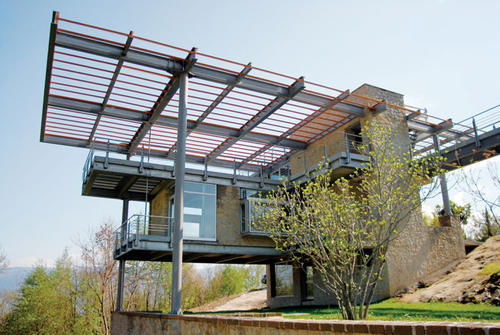 [Image: Sergio Bianchi's Bellegra retreat, via Metropolis]. [Image: Sergio Bianchi's Bellegra retreat, via Metropolis].In an unfortunately subscriber-only article, Metropolis calls our attention to "an artists’ retreat in Bellegra, a small town 40 miles southeast of Rome." The building, we read, was designed by Sergio Bianchi, whose "idea for a Modernist villa designed according to the principles of organic architecture," proved to be so controversial in the context of Italy's "archaic building laws" that it took more than six years to construct. The design itself was "inspired" by Frank Lloyd Wright’s Fallingwater. Metropolis writes that, "although the villa – which has a biological sewage system and a roof fitted for solar panels – is more visually and environmentally harmonious with the landscape than its neighbors, a group of squat clay-tile-roof stucco homes, it provoked strong resistance from local authorities." Those authorities said, somewhat unbelievably, that the building "was too much like science fiction.” 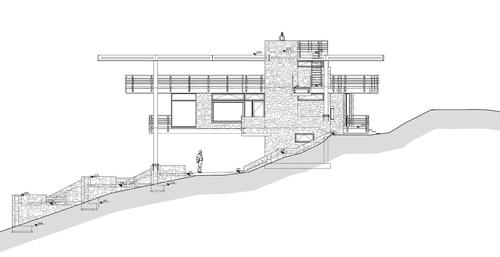 [Image: Sergio Bianchi's Bellegra retreat, via Metropolis]. [Image: Sergio Bianchi's Bellegra retreat, via Metropolis].In any case, I'm posting this really just because I love the deck – in fact, I love the whole structure of this building. I love how, as you can see in that first picture, above, there's a small room, not quite cantilevered, elevated over an outdoor patio – and that, above that room, there's a deck, poised under a slatted horizontal screen that allows you to watch the sky. I also love the little walkway that extends beyond the right-hand side of the picture. The whole thing is like this maze of platforms, decks, patios, and cantilevered rooms, connected by terraces, hanging off a limestone core in the middle of the Italian countryside. I'd like two, please.
 [Image: San Francisco, photographed in profile from Sausalito]. [Image: San Francisco, photographed in profile from Sausalito].In preparation for an overnight business trip to San Francisco this weekend, I was flipping through the Lonely Planet Guide to San Francisco – when I read something that is surely old news for anyone living in that city, but that nonetheless completely blew me away. It turns out that part of San Francisco is actually built on the wrecked and scuttled remains of old ships. 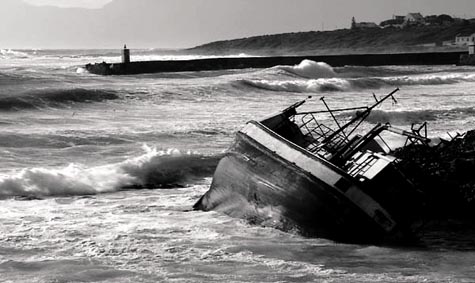 [Image: A shipwreck that has absolutely no connection to San Francisco]. [Image: A shipwreck that has absolutely no connection to San Francisco].The Lonely Planet guide writes that "most of this walk [through the streets near the Embarcadero] is over reclaimed land, some of it layered over the scores of sailing ships scuttled in the bay to provide landfill." Stunned – and absolutely fascinated by this sort of thing – I determined to learn more. And it's true: a good part of coastal San Francisco is not built on solid ground, but on the forgotten residue of buried ships. In an image that makes me want to cry it's so cool, the basements of some 19th-century San Francisco homes weren't basements at all... they were the hulls of lost ships. "As late as Jan 1857," we read, "old hulks still obstructed the harbor while others had been overtaken by the bayward march of the city front and formed basements or cellars to tenements built on their decks. Even now [1888] remains of the vessels are found under the filled foundations of houses." In other words, when you walked downstairs to grab a jar of preserved fruit – you stepped into the remains of an old ship. It's almost literally unbelievable. 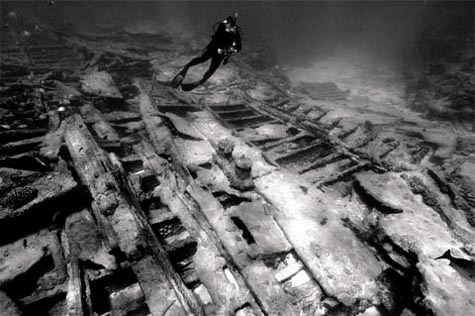 [Image: Another shipwreck – unrelated, as far as I'm aware, to San Francisco]. [Image: Another shipwreck – unrelated, as far as I'm aware, to San Francisco].Best of all, those ships are still down there – and they're still being discovered. In the late 1960s, as San Francisco was building its BART subway system, discoveries of ships and ship fragments occurred regularly. Over the following decades, ships and pieces of ships appeared during several major construction projects along the shore. As recently as 1994, construction workers digging a tunnel found a 200-foot-long (61-meter) ship 35 feet (11 meters) underground. Rather than attempt to remove the ship – which would have been both costly and dangerous – they simply tunneled right through it. When buried ships are found, they’re sometimes looted for bottles, coins, and other valuable antiques frequently found inside. Among the prizes found in the ships have been intact, sealed bottles of champagne and whiskey, nautical equipment, and a variety of personal effects from the passengers and crews. I'm just waiting for some rare and world-destroying virus to be found, festering away in the subterranean hold of an abandoned schooner, forgotten by city historians... Some random cable guy discovers it, digging down into someone's backyard to fix a transmission problem. His shovel cracks through the outer wooden shell of a 19th-century frigate, releasing a cloud of invisible bacteria... he inhales it... his brain begins to bleed... Eli Roth directs the film version. But this also reminds me of the now classic film Quatermass and the Pit – a movie which genuinely needs to be remade, and I would gladly serve as a screenplay consultant – in which London Tube excavations uncover a buried spaceship... out of which emerge weird aliens intent on vanquishing the Queen's English. Or something like that. But the question remains: do you really know what's beneath your house or apartment...? An entire armada of lost fishing ships, now rotting in the mud, nameless and undiscovered, shivering with every earthquake.
 [Images: Japan's Okinotori Islands, via the BBC, next to an unrelated image of a different reef; all reef images used in this post are from different locations]. [Images: Japan's Okinotori Islands, via the BBC, next to an unrelated image of a different reef; all reef images used in this post are from different locations].
The BBC recently revisited the story of why Japan is now growing coral reefs in a bid to extend their territorial sovereignty into the Philippine Sea.
Successfully transplanting and cultivating these reefs would, in theory, allow Japan "to protect an exclusive economic zone off its coast"—expanding Japanese maritime power more than 1,000 miles south of Tokyo. According to the Law of the Sea, Japan can lay exclusive claim to the natural resources 370km (230 miles) from its shores. So, if these outcrops are Japanese islands, the exclusive economic zone stretches far further from the coast of the main islands of Japan then it would do otherwise. To bolster Tokyo's claim, officials have posted a large metal address plaque on one of them making clear they are Japanese. They have also built a lighthouse nearby. However, the major geopolitical question remains: are these reefs truly islands?
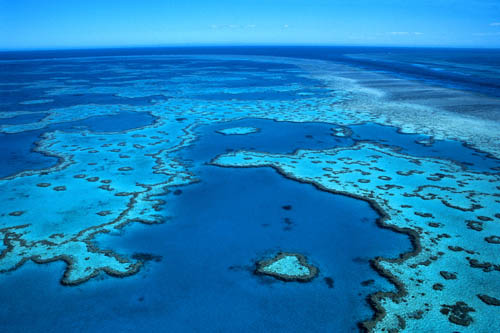 At the moment, the Okinotori Islands (as they're called) are merely "rocky outcrops"; but, by artificially enhancing their landmass through reefs—using reef "seeds" and "eggs"—Japan can create sovereign territory.
This means that they'll win economic control over all the minerals, oil, fish, natural gas, etc. etc., located in the area—providing friendly sea routes for American military ships in the process.
The U.S., of course, thinks that Japan's sovereign reefs are a great idea; China, unsurprisingly, thinks the whole thing sucks.
In fact, we read: Chinese interest in Okinotori lies in its location: along the route U.S. warships would likely take from bases in Guam in the event of a confrontation over Taiwan. China's efforts to map the sea bottom, apparently so its submarines could intercept U.S. aircraft carriers in a crisis, have drawn sharp protests from Japan that China is violating its EEZ. Which means that these artificial encrustations of living matter, planted for political reasons at the beginning of the 21st century, could very well influence the future outcome of marine combat between the United States and China.
A tiny bit more information about all this is available at the Times.
 So the rest of this story could go in any number of directions:
1) A speculative survey of other "rocky outcrops" and manmade reefs, to see who might be able to claim them and why. For instance, if Japan's reef-based territorial ambitions are successful, could this establish a legal precedent for other such experimental terrains?
Or perhaps it could mean that the U.S. will turn away from Treasury-depleting global military adventurism to spend money on more interesting projects within its own borders—funding a whole new series of Hawaiian islands, designed by Thom Mayne, that would extend Hawaii archipelagically toward Asia...
Greece, inspired, would then expand the Cyclades with a cluster of designer islands, slowly growing to dominate the Mediterranean once again—a kind of inverse- Odyssey in which the islands themselves do all the traveling...
Or maybe there'll be a whole new terrestrial future in store for Scotland's Outer Hebrides, or for the Isle of Man, or for Friesland—or perhaps even a whole new Nova Scotia, extending hundreds of nautical miles into the waters of the north Atlantic, a distant, fog-shrouded world of melancholic introspection, visited by poets...
2) It's worth remembering that the possession of land and territory has not always been a recognized marker of political sovereignty—so the Earth, in the sense of geophysical terrain, is here being swept up into a model of human governance that has only existed for a few hundred years, and which may only exist for a few decades more. So, under a different political system, these artificial reefs would be quite literally meaningless.
3) The generation of new territory for the purpose of extending—or consolidating—political power is nothing new. As but one example, I happen to be reading The Conquest of Nature: Water, Landscape, and the Making of Modern Germany, a book that "tells the story of how Germans transformed their landscape over the last 250 years by reclaiming marsh and fen, draining moors, straightening rivers, and building dams in the high valleys."
The relevance of this here, in the context of artificial Japanese reefs in the south Pacific, is that Frederick the Great used hydrological reclamation projects—i.e. marsh draining and river redirection—literally to create new territory; this expanded the political reach of Prussia by generating more Earth upon which German-speaking settlers could then build farms and villages. All in all, this was a process of both "agricultural improvement and internal colonization," and it "increasingly assumed the character of a military operation."
As David Blackbourn, the book's author, further notes: "External conquests created additional territory on which to make internal conquests, spaces on the map out of which new land could be made." Indeed: "For Prussia, a state that was expanding through military conquest across the swampy North European plain, borders and reclamation went together."
4) Finally, last week New Scientist ran a whole bunch of little articles called "The last place on Earth..." In each case, that leading phrase was followed by a subheading, such as: " ...to be discovered," or " ...where no explorer has set foot."
Another of those articles was: " ...to be unclaimed by any nation."
As the magazine comments in that piece: "States will go to great lengths to secure territorial claims over what appear to be worthless pieces of land." After all, "owning even a remote rock can significantly extend a nation's access to marine resources such as oil and fish."
But those "great lengths" to which the nations of tomorrow may someday go could include the outright geo-architectural construction of whole new landmasses, islands, and offshore microcontinents. These terrains will be governed by Kurtzian technocrats, with iron fists, whose unchecked cruelty will inspire the literary classics of the 22nd century...
In any case, all of these points seem to imply that architects may need to brush up on their marine geotechnical skills—as well as on the legal issues surrounding the archipelagic future of political sovereignty.
 [Image: From "City of the Immortals" by Michelle Lord]. [Image: From "City of the Immortals" by Michelle Lord].Artist Michelle Lord, whose " Future Ruins" we featured here on BLDGBLOG the other day, has another project on display this year as part of Architecture Week in the UK. This project, the "City of the Immortals," inspired by a Jorge Luis Borges short story called " The Immortal," gives viewers a shadowy glimpse into Lord's ongoing "fascination with fictional or un-built environments." 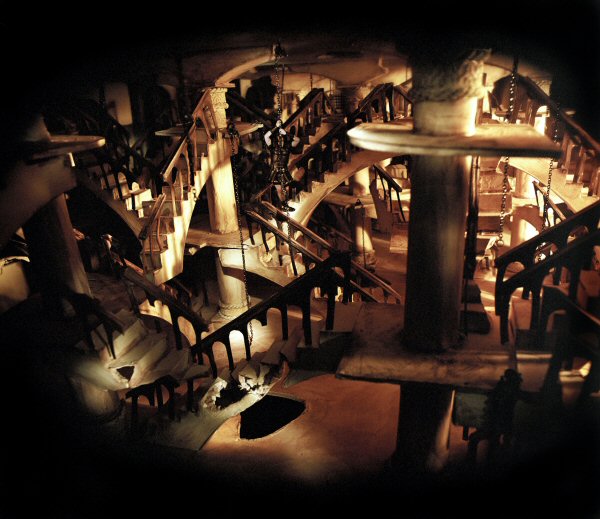 [Image: From "City of the Immortals" by Michelle Lord; also available in a slightly bigger version]. [Image: From "City of the Immortals" by Michelle Lord; also available in a slightly bigger version].This work in particular represents "a vast fictional topography that exists within the walls of a mythological Roman city." Within that city, according to the Borges story, "a lone figure traverses its magnificent, eternal architecture in search of immortality." At one point Borges describes how this narrator ascends a ladder, pulling himself up toward "a circle of sky" – through which he promptly pokes his head, making a discovery: "I began to glimpse capitals and astragals," he tells us, "triangular pediments and vaults, confused pageants of granite and marble. Thus I was afforded this ascension from the blind region of dark interwoven labyrinths into the resplendent City."  [Image: From "City of the Immortals" by Michelle Lord; see bigger]. [Image: From "City of the Immortals" by Michelle Lord; see bigger].The story continues: A labyrinth is a structure compounded to confuse men; its architecture, rich in symmetries, is subordinated to that end. In the palace I imperfectly explored, the architecture lacked any such finality. It abounded in dead-end corridors, high unattainable windows, portentous doors which led to a cell or pit, incredible inverted stairways whose steps and balustrades hung downwards. Other stairways, clinging airily to the side of a monumental wall, would die without leading anywhere, after making two or three turns in the lofty darkness of the cupolas. In any case, Lord has physically constructed the architecture described by Borges; her interiors thus "intentionally evoke spatial and geometric confusion, where great pillars extend into infinity and endless staircases appear to intertwine like a three dimensional maze to form a ‘nonsense’ structure or architectural folly."  [Image: From "City of the Immortals" by Michelle Lord; also available in a moderately larger version]. [Image: From "City of the Immortals" by Michelle Lord; also available in a moderately larger version].Citing Piranesi as an influence, she assembles a "composite of both the real and the invented." This "demonstrates the power of paper architecture to convincingly simulate reality, where a freshly made model can evoke a lengthy history and its diminutive scale conjure up a life-size space. An intricate hybrid of photography, sculpture and architecture; the artificial eye of the camera subtly transforms these hand crafted models into a large sprawling complex, a new imaginary city."  [Image: From "City of the Immortals" by Michelle Lord; also available in a slightly bigger version]. [Image: From "City of the Immortals" by Michelle Lord; also available in a slightly bigger version].Lord's "City of the Immortals" is on display till June 24 in Birmingham, England. (Vaguely related: Edinburgh).
 [Image: From "Future Ruins" by Michelle Lord]. [Image: From "Future Ruins" by Michelle Lord].Over on Ballardian we read about a new project by artist Michelle Lord, called " Future Ruins." Lord writes: “Inspired by author J.G. Ballard’s literary visions of modernist architectural design and his prophetic views on the technological demise of the urban environment, Future Ruins is a photographic critique of the urban planning of the 1970s and Ballard’s novels of the same period." 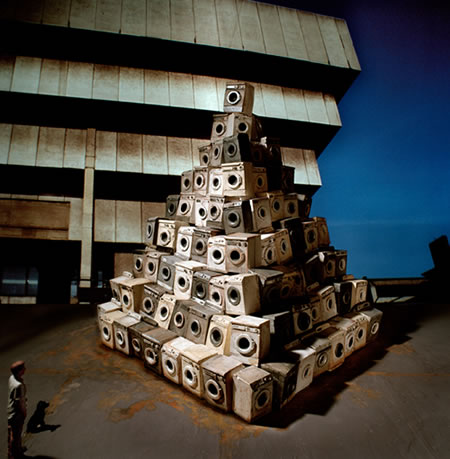 [Image: From "Future Ruins" by Michelle Lord]. [Image: From "Future Ruins" by Michelle Lord]."Set against a backdrop of Birmingham’s few remaining concrete structures such as Spaghetti Junction, Central Library and New Street Station signal box," Lord continues, " Future Ruins aims to highlight the temporality of our landscape, particularly at a time when Birmingham has embarked on a process of regeneration in order to redefine itself." Familiar architectural locations around the city take on the appearance of evacuated spaces occupied by strange, carefully arranged structures, built from the technological detritus of abandoned television sets, cars, computers and domestic appliances. The show is on display until June 23, as part of the UK's 2007 Architecture Week. Lord, meanwhile, is also the artist behind " Four Corners," a photographic exploration of "fictional space." According to the 24 Hour Museum: "The images featured in Four Corners tell the tale of a woman who becomes alienated from the room she occupies as it takes on a strange life of its own. Furniture defies gravity and ghostly figures emerge from the shadows in the dreamlike chamber depicted, understandably giving our subject the creeps as her room appears to transform itself." (For those of you who like this sort of thing, Ballardian actually interviewed me about architecture, urban design, and the novels of J.G. Ballard, back in November).
 Instead of TV, it seems, you can watch 3D reconstructions of ancient storms – hopefully in surround-sound. New Scientist reported a few weeks ago that researchers will soon "be able to visually recreate past typhoons, hurricanes and cyclones, then stand in the middle and watch as the weather pattern swirls around them." It's the storm room: a "simulator that crunches real storm data and turns it into 3D images that can be viewed with virtual-reality goggles." What about the home entertainment version, though? Putting this thing to architectural use. You throw Hurricane Floyd – or Typhoon Tip – up on the walls and read a book while it spins... Or a new kind of teenage rebellion breaks out in the suburbs of middle America: angry sixteen year-olds program tropical storms into the walls of their bedrooms and make their parents faint with vertigo. It's the immersive, weather-reconstructive cinema of the future. (A tiny bit more information is available at New Scientist).
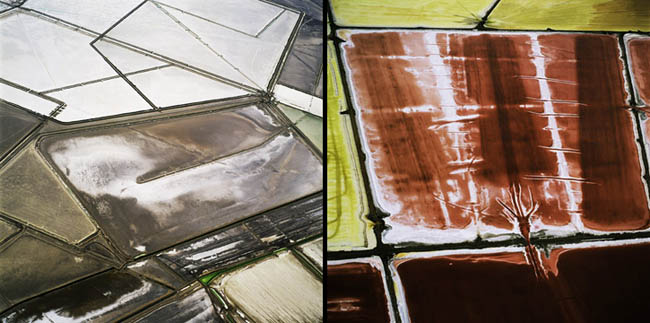 [Image: Two landscapes photographed from above by David Maisel; from Terminal Mirage]. [Image: Two landscapes photographed from above by David Maisel; from Terminal Mirage].
I'm excited to announce that I'll be participating in a roundtable discussion, on June 28, hosted by the Nevada Museum of Art in Reno.
Some long-term BLDGBLOG readers might remember that I interviewed photographer David Maisel about a year and a half ago for Archinect; well, David will be leading a guided tour of his photographs (at noon on June 28) at the Nevada Museum of Art, followed by a lecture about those images (at 7pm, the same day), by writer William L. Fox – ending, finally, with a roundtable discussion featuring Fox, Maisel, and myself.
The Nevada Museum of Art describes Fox as an author and independent scholar who "has spent three decades studying and writing about the ways in which humans understand where they are in landscapes, often focusing on art, mapping, and cognitive science." His many, many books include Driving to Mars: In the Arctic with NASA... and Terra Antarctica: Looking into the Emptiest Continent. He's also got a website.
Fox's work has come up many times on this blog; see this post, for instance, about high winds in Antarctica, carving musical instruments out of the rocks, or this post, in which huge underground spheres in the south polar glaciers are used as a new kind of cathedral, or even this post, in which settlers on Mars confront seemingly inescapable geo-simulations...
Finally, if you haven't read it yet, don't miss the Archinect interview with David Maisel.And I owe a huge thanks to the Nevada Museum of Art for inviting me up to participate in the first place.
 [Image: The future of the private home: a $475 million, custom Airbus A380; illustration by Bryan Christie for Wired]. [Image: The future of the private home: a $475 million, custom Airbus A380; illustration by Bryan Christie for Wired].According to Wired, an "undisclosed billionaire" has paid $475 million for a private Airbus A380 passenger jet. The plane weighs 361 tons, is eight stories tall, and can hold up to 500 passengers – but this nameless billionaire will simply be using it as "one of the most expensive mobile homes in the world" (complete with $150 million in "custom upgrades"). For whatever mysterious reasons of his or her own, the plane's owner has taken to calling the custom airplane "Project Trinity." Which is actually interesting, because I was just thinking the other day that there are no flying churches – at least for mainstream congregations – and I don't think there are any sky mosques. In other words, the architectural history of the Church doesn't, to my knowledge, include any airplanes. Gothic cathedrals, sure – but no StratoPulpit™. No CloudChurches (©). And Islam has no AirMosques®. In fact, this would make an interesting addition to the Pamphlet Architecture series: speculative religious architecture, creatively re-using vehicles from the private air transport industry. In any case, while we're on the subject of extravagant private homes, as everyone in the world heard at least once last week, Mukesh Ambani, the richest man in India, is constructing himself a private skyscraper in Mumbai.  [Image: Mukesh Ambani's 60-story house; via the Mumbai Mirror]. [Image: Mukesh Ambani's 60-story house; via the Mumbai Mirror].Ambani's new home will be "over 170m tall," the BBC reported, and it will require "an army of 600 staff to manage it." All said, the tower will cost as much as $1 billion to construct (or 1/20th of Ambani's reported wealth). According to the Mumbai Mirror, the house has been named "Residence Antilia." The Mirror goes on to explain that Antilia is "a phantom island said to lie in the Atlantic Ocean far to the west of Spain. This mythical island had several other names such as Isle of Seven Cities, Ilha das Sete Cidades (Portuguese), Septe Cidades, Sanbrandan (or St Brendan), etc." Some people say Antilia is actually Manhattan; others say it's one of the Canary Islands; and yet others say it would make an awesome summer project for architectural design studios: design Antilia, an artificial island – or series of islands – "far to the west of Spain." Briefly, then, Residence Antilia will include: • space for 168 "imported" cars, divided across six floors
• an entire floor for "car maintenance," with an "in-house service centre"
• an "entertainment floor"
• terraces, balconies, and roof gardens
• a "health" floor, including "the latest gym equipment" and a pool
• three helipads
• two basement levels Etc. etc. The expenditure is appalling, and the obvious contrast to the poverty of everyday Mumbai is almost literally unbelievable; and yet I have a soft spot for weird architectural projects built by really rich people – and a private skyscraper would make such a fantastic setting for a novel or film, not to mention a wild place to be left alone for the weekend, that I have to be honest and admit that I find this project pretty interesting. Is it well-designed (by architects Perkins + Will)? It's too hard to tell from these images. Is it socially just? Of course not. But it's an awesome addition to the growing pantheon of extreme private homes – and the narrative implications that it presents for future Ballardian artworks (novels, films, videogames) are, for me, stunning. At the very least: a Bollywood Home Alone. (Vaguely related: $5.4 billion).
 [Image: Iceland's Vatnajökull glacier].The Guardian [Image: Iceland's Vatnajökull glacier].The Guardian tells us today about a "unique work of art" that "invites viewers to phone a glacier in Iceland – and listen to its death throes, live, through a microphone submerged deep in the bitterly cold lagoon." The weatherproof microphone thus "relays the splashes, creaks and groans as great masses of melting ice sheer off and crash into the water."  [Image: Iceland's Vatnajökull glacier]. [Image: Iceland's Vatnajökull glacier].You just have to call the following number: +44 (0) 7758 225698 (a British mobile phone – non-Brits, beware huge long-distance fees!) to "make direct contact with the polar icecap." However, the article warns us: "Only one caller at a time can get through: [artist Katie] Paterson recommends the small hours of the morning." So, if you're extremely rich and cursed with insomnia, you can always lull yourself to sleep, sitting up at 3am near the kitchen window with your telephone pressed hard against your ear, listening to the groan of distant glaciers... I tried to get through a few hours ago, but dialed the wrong number – connecting instead to the subterranean roar of Mt. Hood. Perhaps there should be a telephone directory for natural phenomena. (Thanks, Alex! Earlier on BLDGBLOG: To eavesdrop on breaking glaciers from within and When landscapes sing: or, London Instrument).
 [Image: Turning The Place Over by Richard Wilson; image via the Daily Mail]. [Image: Turning The Place Over by Richard Wilson; image via the Daily Mail].In a project that "will astonish the commuters of Liverpool," sculptor Richard Wilson has turned part of a building's facade inside-out. As if learning from Gordon Matta-Clark, Wilson sliced an "egg-shaped section" out of the building's facade – "fixing the eight metre diameter piece on a pivot" so it can spin.  [Image: Turning The Place Over by Richard Wilson; image via the Daily Mail]. [Image: Turning The Place Over by Richard Wilson; image via the Daily Mail].The "rotating facade" will thus "reveal a glimpse of the interior" – for the low, low price of £450,000. (Thanks, Nicky!)
 [Image: A glimpse of Chizhevsky Lessons by Micol Assaël; image courtesy of ArtForum]. [Image: A glimpse of Chizhevsky Lessons by Micol Assaël; image courtesy of ArtForum].Named after a Russian scientist "who explored the correlation between solar activity and historical events," Chizhevsky Lessons is an art installation in Basel, Switzerland, by Micol Assaël. The gallery it's displayed in looks a bit like an empty room. You do see a series of copper plates hanging above you in space, and there's a triangle, attached to wires, hovering alone in the center, like a Modernist chandelier. But aside from those somewhat occultish pieces of interior decor, the place looks perfectly normal. Still, it doesn't feel right: Upon entering, one first senses a disquieting buzz sound, followed by a tickling of the skin as one’s body hair stands on end. It’s the loaded atmosphere that precedes a thunderstorm, but re-created artificially with a cascade generator, a transformer, copper plates, and, hung three meters above the floor, a thin wire net that fills the room with negatively charged ions. One cannot help but experience an immediate physical reaction... Sure, it's basically just a huge science experiment – but I can't stop myself wondering what a slightly less powerful, much more well-hidden model could do for you. If you installed it in, say, a corporate board room: the CEO looks down upon her minions with derision and rage – because they didn't finish the monthly report. As she speaks they hear a disquieting buzzing sound, followed by a tickling of the skin as one's body hair stands on end... It'd be like the Greek myths, reenacted through 21st century technology. The divine encounter: install six of these in St. Peter's. Or, for that matter, install one, secretly, in your bedroom – and wait for the sparks to fly. (Thanks again to Dan Polsby!)
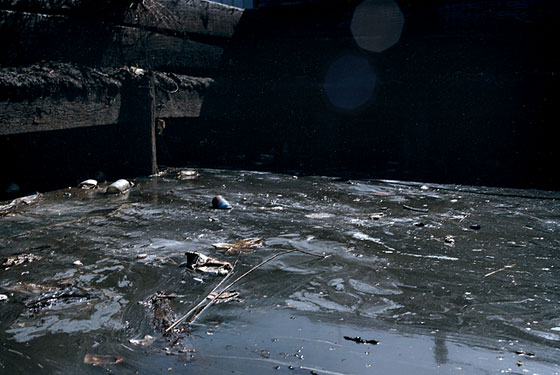 [Image: The Brooklyn sludge slowly surfaces... Photo by Jeff Riedel for New York Magazine]. [Image: The Brooklyn sludge slowly surfaces... Photo by Jeff Riedel for New York Magazine].The largest oil spill in American history is apparently: 1) in New York City, 2) nearly a century old, and 3) beginning to re-surface under Greenpoint, Brooklyn. An article in New York Magazine this week dives head-first into the spill, asking us to "imagine a viscous tar-colored blob stretching amoebalike through the Earth." This viscous blob is really "ten million gallons of toxic gunk trapped in the Brooklyn aquifer," made of "gasoline, solvents, and associated poisons bubbling up from the very ground." These associated poisons include naptha, from which napalm is manufactured. The subterranean Brooklyn blob represents "more than a century’s worth of spills, leaks, and waste dumped by oil companies" – and it's "pooled into a vast underground lake, more than 55 acres wide and up to 25 feet thick." Not only has it infiltrated the region's water supply (don't worry: they pipe water in from the Catskills), but it means you can set the soil on fire. 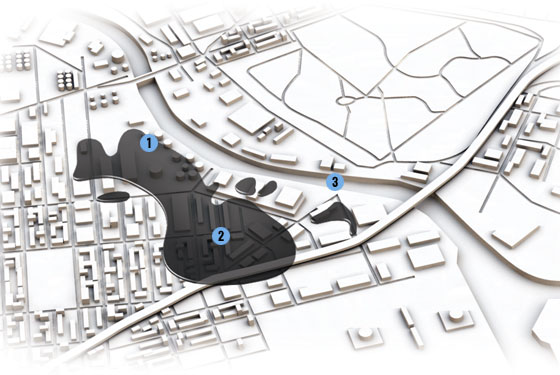 [Image: A map of the subsurface blob; illustration by Jason Lee, courtesy of New York Magazine]. [Image: A map of the subsurface blob; illustration by Jason Lee, courtesy of New York Magazine].Worse, thousands of people now live on top of it... From the article: No one really knows what the consequences of Greenpoint’s oil spill have been – or will be. It’s like the dust from 9/11, the chemicals dumped at Love Canal, the nuclear meltdown at Three Mile Island, or even global warming. Do we ever really know their costs? Perhaps twenty years from now epidemiological studies will reveal a link between living in Greenpoint and dying of cancer. Though it seems the cancer rate may already be on the rise. In any case, I could go on and on – or you could just read the whole article. It's not a life-changing read – and it's conclusion is strangely anticlimactic – but the very idea of a black tarry blob drifting beneath the streets of New York is far too awesome to resist. (Thanks to Dan Polsby for the tip!)
 [Image: A glimpse of London's LightHive, by Alex Haw, on display last week]. [Image: A glimpse of London's LightHive, by Alex Haw, on display last week].An installation called the LightHive closed last week at the Architectural Association in London. Designed by architect, actor, theorist, and writer Alex Haw, the hive functioned as a new form of " luminous architectural surveillance," somewhere between sculpture, optical device, and high-end interior decoration – an immersive chandelier, if you will. According to the UK-based ArtsHub, Haw's LightHive "pushes CCTV into another dimension."  [Image: Preliminary point-cloud study for the LightHive, executed by Marc Fornes]. [Image: Preliminary point-cloud study for the LightHive, executed by Marc Fornes].Specifically, the hive consists of "a surveillance network" – connected to nearly 7.5km of LED wiring – that "records the movement of people through the building" (where "the building" is London's Architectural Association in Bedford Square). The LightHive then "transmutes the energy into bursts of light, which create an 'immersive form of 3d CCTV'."    [Images: Glimpses of the LightHive, an indoor constellation aware of those who view it. Image one, two, and three – and a lot more here]. [Images: Glimpses of the LightHive, an indoor constellation aware of those who view it. Image one, two, and three – and a lot more here].From a description of the exhibition: The space thus operates like a 3D X-ray of the building’s activity, a kind of constantly updating surround-light CCTV, a spatial model of the entire School’s performance fluctuating over the course of hours, days and weeks. I'll admit to being a tad unclear about how the ensuing displays of light manage to represent – or not – the presence of human beings; but I love the idea.   [Images: The LightHive as digital model (by Marc Fornes) and material execution]. [Images: The LightHive as digital model (by Marc Fornes) and material execution].I love just thinking about the possibility that, say, all the lights in Bloomsbury, from desk lamps and bathroom fixtures to fluorscent bulbs at the nearest Pret a Manger, might someday act as a huge sensory mechanism, responding and dimming in response to the passage of people in the streets. Or parts of Tokyo light up, LightHive-like, illustrating in real-time the level of pedestrian traffic down the King's Road (or 5th Avenue, or Kastanienallee). Or install one of these things in the International Space Station, to register human movement through the back rooms of Mission Control, far below... Anti-gravitational light sculptures in space.   [Images: 7.5km of LED wiring plus "a last view of the lush multicoloured universe of RS232 DMX cables" required for the LightHive]. [Images: 7.5km of LED wiring plus "a last view of the lush multicoloured universe of RS232 DMX cables" required for the LightHive].In any case, this would not be the first time Haw has explored the artistic application of surveillance technology. His 2005 film CCLTV, for instance, took a long look at "the astonishing density of CCTV positions along the Euston Road" in London; and Haw wrote an article for AA Files a few years back on the increasingly Panoptic use of surveillance cameras in the greater London area.  [Image: From CCLTV, a film that exposes "the astonishing density of CCTV positions along the Euston Road"; directed by Alex Haw]. [Image: From CCLTV, a film that exposes "the astonishing density of CCTV positions along the Euston Road"; directed by Alex Haw].Loads of more info – including some technical specifics – about the LightHive can be found over on Marc Fornes's site. And if you managed to see the hive itself in action last week, let me know how it was... (Thanks to Alex Haw for the tip).
 As if tapping into a rival spiritual tradition, Pope Benedict XVI will soon become "the first pontiff to harness solar power to provide energy for the Vatican," according to the BBC. "The deteriorating cement roof tiles of the Paul VI auditorium will be replaced next year with photovoltaic cells to convert sunlight into electricity." The BBC's all too short news item goes on to report that the Vatican "is considering placing solar panels on other buildings although St Peter's Basilica and other historical landmarks will not be touched." But why not touch them? Solar-powered cathedrals lining the bombed-out fields of Europe! How much more spiritually energizing can you get than plugging directly into that ongoing hydro-helium reaction in space? Teaching theology by the contained light of solar flares – astral disasters captured flashing, as power surges down consecrated halls of painted saints. Frescoes gleam. Christianity meets Mithraism in architectural form. John 8:12 – I am the Light of the World – taken literally. In fact, the whole book of John is arguably about the solar power industry.  In any case, are solar panels the new stained glass windows? And might Christianity be subtly transformed by this encounter with the celestial realm? Apollonian light burning where there once were candles? After all, Christianity has been turning its doctrinal face away from the stars for far too long.  Imagine this heaving, propulsive thing lighting up cathedrals and prayer books! Shining in libraries and guiding pilgrims through churches, casting shadows in the courtyards of monks. Christendom should have been solar-powered all along – installing astronomical monstrosity at the very heart of the Catechism. Seriously, though, do the metaphoric implications of the Vatican going solar outweigh any sort of practical message we might otherwise gain from this bit of news? Isn't solar power a major doctrinal shift for contemporary Christianity? Can everyday technology truly embody religious ideals? (Earlier on BLDGBLOG: In space, no one can hear you pray and The Heliocentric Pantheon: An Interview with Walter Murch).
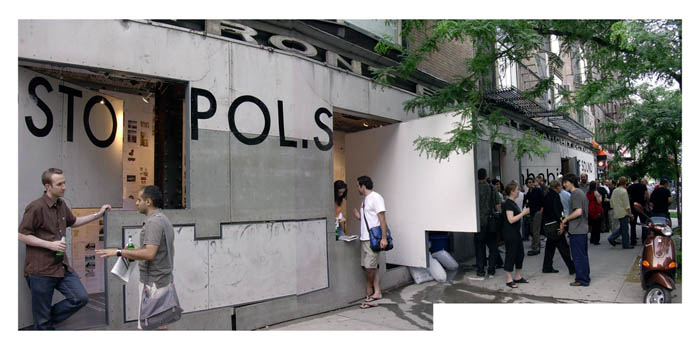 [Image: The Postopolis! closing party kicks off; photo by John Hill of Archidose]. [Image: The Postopolis! closing party kicks off; photo by John Hill of Archidose].
Well, I'm back in Los Angeles, after one of the longest and most surreal days of my life, flying nearly sleepless across mountains and canyonlands mere hours after saying goodbye to everyone at the Storefront, leaving New York before the music had ended, as the print-outs of our blogs were literally blowing off the walls and whole tubs' worth of ice – emptied of at least three hundred beer bottles within minutes – melted into rivers across the sidewalk, and before it even seemed possible that Postopolis! had really come to an end – but there it was: the whole thing was over, already something from yesterday, and now last week, and so I'm in Los Angeles again with no real proof that it ever happened, except for some bookmarks and some photos and some business cards I picked up along the way and this almost painfully happy nostalgia for every aspect of it, feeling more like a ghost who invisibly revisited the east coast, passing through the neutron star of New York City, Manhattan, a now artificial island so dense with structure that it bends the lives of those around it; but there we all were for a week, hanging out and talking about space, time, and architecture in the sweat and heat together.
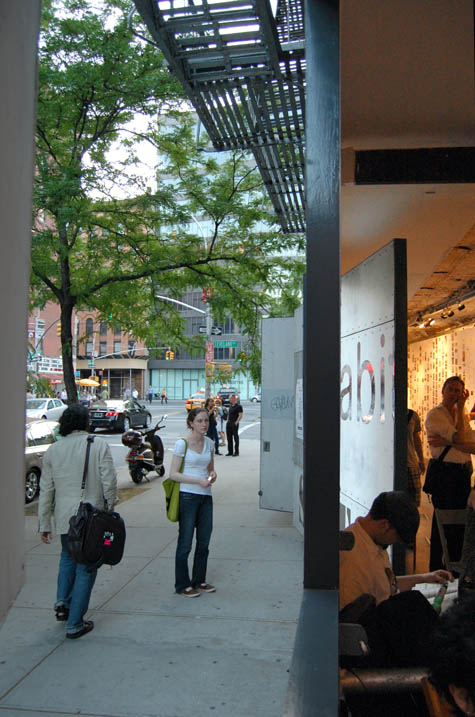 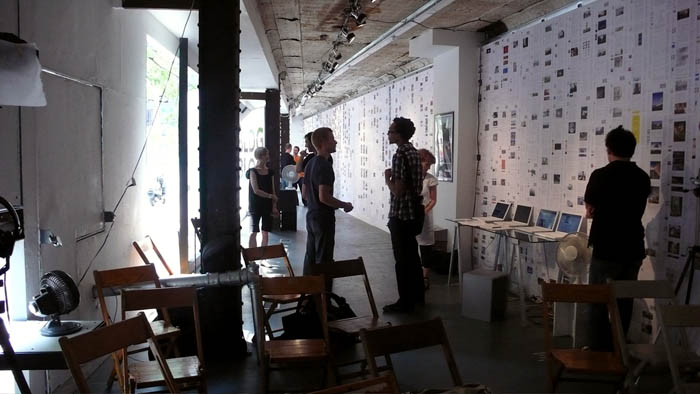 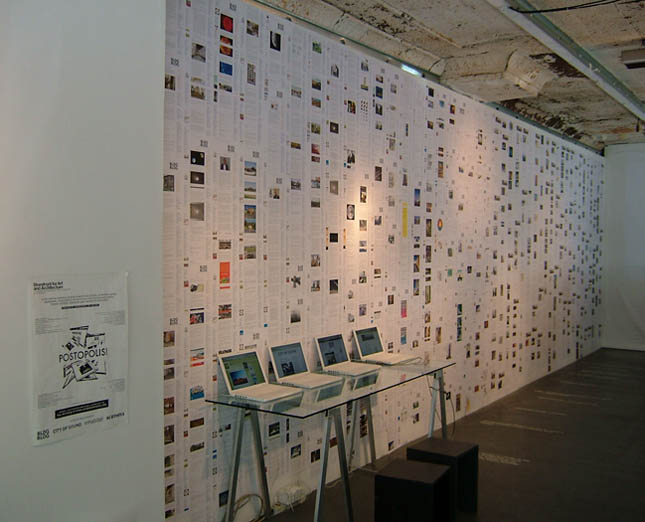 [Images: The Storefront for Art and Architecture; photos, top to bottom, by Nicola Twilley, Dan Hill, and BLDGBLOG]. [Images: The Storefront for Art and Architecture; photos, top to bottom, by Nicola Twilley, Dan Hill, and BLDGBLOG].
And it was a blast.
All of which means I'll start posting again here, about Postopolis! itself – and the speakers who came through, and the city, and the people I met, and the weather systems that pass through Manhattan seemingly detached from the planet – and about regular old architectural news, from the private skyscraper of a man in India to the Italian fate of urban rubbish, soon enough.
But I just want to say a huge thanks, first of all, to my fellow Postopolitans: Dan Hill of City of Sound, Jill Fehrenbacher of Inhabitat, and Bryan Finoki of Subtopia – I already miss you! How strange to spend nearly nine hours a day with someone, for an entire week, only to leap onto an airplane... and wonder if you'll ever see them again.
All the more reason to host Postopolis! 2 next year.
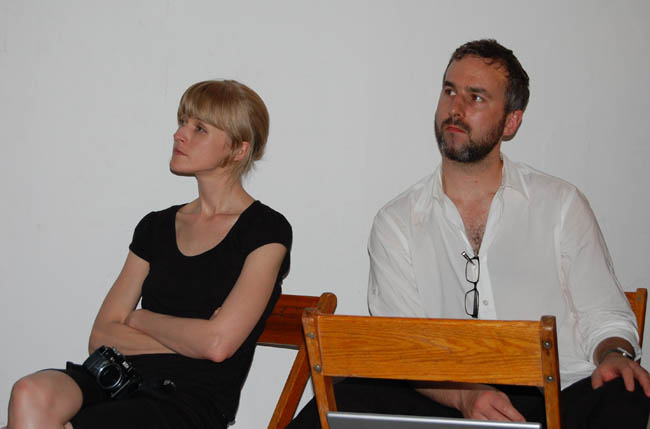  [Images: (top) Jill Fehrenbacher and Dan Hill watch one of the speakers; (bottom) Bryan Finoki cools off by a fan. Photos by Nicola Twilley]. [Images: (top) Jill Fehrenbacher and Dan Hill watch one of the speakers; (bottom) Bryan Finoki cools off by a fan. Photos by Nicola Twilley].
But I also owe a huge thanks to the staff of the Storefront for being there, and for setting up the place, and for slapping our logos onto the facade, and for finding us all a place to stay (more about our hotel soon – specifically the plumbing).
To my wife for the help, for the photos, and for putting up with my jangly nerves.
To everyone who attended – the audience was at least half the point of putting this thing together, and your questions, comments, complaints, flashing photo bulbs, and laughter were a huge inspiration.
To DJ /rupture and N-RON for vibrating all of southern Manhattan Saturday night with giant triangular slabs of bass blasting out and downward from the Storefront on Kenmare Street.
To all our speakers, for coming out in 1000% humidity to deliver un-air-conditioned speeches through sometimes squealing microphones as dumptrucks rattled by blowing air horns – the event would literally have been nothing without your participation! It was also great to meet so many people with whom I've been in email contact for months, if not years, and to realize that all those people out there on the internet, sending you things, are real: you can shake their hand, and have a glass of wine with them, and laugh.
And, of course, most of all, I owe a gigantic thanks to Joseph Grima, Director of the Storefront for Art and Architecture, who came up with the idea for Postopolis! in the first place; who invited me and everyone else out there to New York City to attend; who made all the ends meet administratively, spatially, technically, and financially; and who put up with the goofy, adolescent nervousness I know at least I personally experienced several times each day.
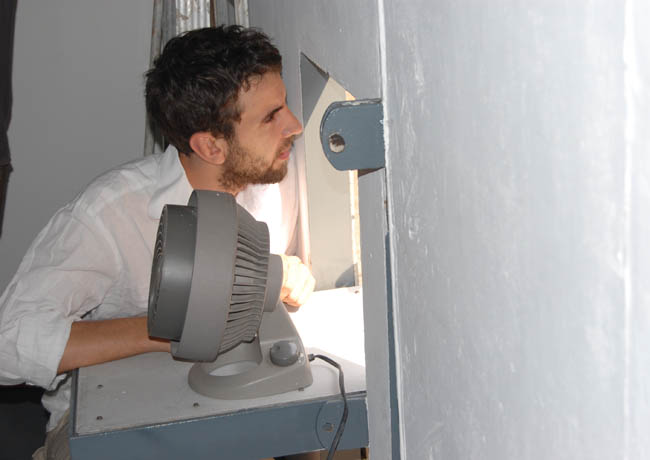 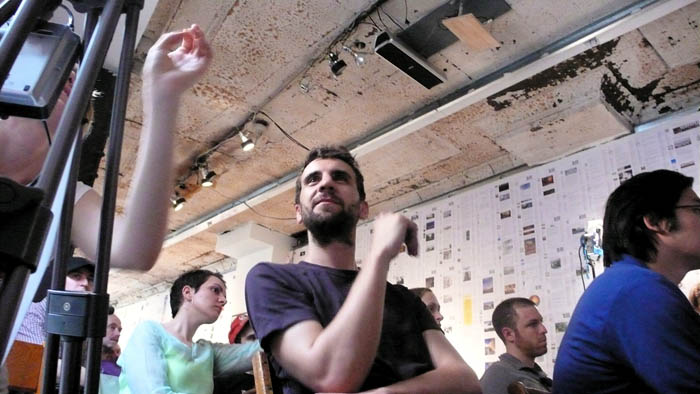 [Images: (top) Joseph Grima peers out through the facade of the Storefront for Art and Architecture (photo by Nicola Twilley); (bottom) Joseph Grima, photographed by Dan Hill]. [Images: (top) Joseph Grima peers out through the facade of the Storefront for Art and Architecture (photo by Nicola Twilley); (bottom) Joseph Grima, photographed by Dan Hill].
Thank you, Joseph!
Finally, thanks to the BLDGBLOG readers who didn't really care about Postopolis! and who don't live anywhere near Manhattan, yet who sat through all these more or less content-less updates while the event spun on. Regular posts will continue shortly.
More soon – but, seriously, thanks again to everybody involved with Postopolis!
I had a sleepless and amazing time, and I already miss everything.
But now I'm home.
 [Image: Looking down at the desert of greater Los Angeles, with Postopolis! already far too far behind us; photo by Nicola Twilley].
(PS: If you're looking for more photos and some video feeds of the event, don't miss all the stuff up on YouTube or BLDGBLOG's Postopolis! Flickr set and the public Postopolis! Flickr pool). [Image: Looking down at the desert of greater Los Angeles, with Postopolis! already far too far behind us; photo by Nicola Twilley].
(PS: If you're looking for more photos and some video feeds of the event, don't miss all the stuff up on YouTube or BLDGBLOG's Postopolis! Flickr set and the public Postopolis! Flickr pool).
|
|
 [Image: A BMW ad, showing us London geologically mixed, across a series of bridges and viaducts, with, say, Rio de Janeiro, Angkor Wat, and maybe... Macchu Picchu? View larger. Found via things magazine].
[Image: A BMW ad, showing us London geologically mixed, across a series of bridges and viaducts, with, say, Rio de Janeiro, Angkor Wat, and maybe... Macchu Picchu? View larger. Found via things magazine].
 [Image: Outside the space hotel... in space. You can see the Earth's curvature in the lower right-hand corner. Courtesy of
[Image: Outside the space hotel... in space. You can see the Earth's curvature in the lower right-hand corner. Courtesy of  [Images: Three covers from
[Images: Three covers from  [Image: Sergio Bianchi's Bellegra retreat, via
[Image: Sergio Bianchi's Bellegra retreat, via  [Image: Sergio Bianchi's Bellegra retreat, via
[Image: Sergio Bianchi's Bellegra retreat, via  [Image: San Francisco, photographed in profile from Sausalito].
[Image: San Francisco, photographed in profile from Sausalito]. [Image: A shipwreck that has absolutely no connection to San Francisco].
[Image: A shipwreck that has absolutely no connection to San Francisco]. [Image: Another shipwreck – unrelated, as far as I'm aware, to San Francisco].
[Image: Another shipwreck – unrelated, as far as I'm aware, to San Francisco]. [Images: Japan's Okinotori Islands, via the
[Images: Japan's Okinotori Islands, via the  At the moment, the Okinotori Islands (as they're called) are merely "rocky outcrops"; but, by artificially enhancing their landmass through reefs—using
At the moment, the Okinotori Islands (as they're called) are merely "rocky outcrops"; but, by artificially enhancing their landmass through reefs—using  So the rest of this story could go in any number of directions:
So the rest of this story could go in any number of directions:  [Image: From "City of the Immortals" by Michelle Lord].
[Image: From "City of the Immortals" by Michelle Lord]. [Image: From "City of the Immortals" by Michelle Lord; also available in a slightly
[Image: From "City of the Immortals" by Michelle Lord; also available in a slightly  [Image: From "City of the Immortals" by Michelle Lord; see
[Image: From "City of the Immortals" by Michelle Lord; see  [Image: From "City of the Immortals" by Michelle Lord; also available in a moderately
[Image: From "City of the Immortals" by Michelle Lord; also available in a moderately  [Image: From "City of the Immortals" by Michelle Lord; also available in a slightly
[Image: From "City of the Immortals" by Michelle Lord; also available in a slightly  [Image: From "
[Image: From " [Image: From "
[Image: From " Instead of TV, it seems, you can watch 3D reconstructions of ancient storms – hopefully in surround-sound.
Instead of TV, it seems, you can watch 3D reconstructions of ancient storms – hopefully in surround-sound. [Image: Two landscapes photographed from above by David Maisel; from
[Image: Two landscapes photographed from above by David Maisel; from  [Image: The future of the private home: a $475 million, custom
[Image: The future of the private home: a $475 million, custom  [Image: Mukesh Ambani's 60-story house; via the
[Image: Mukesh Ambani's 60-story house; via the  [Image: Iceland's
[Image: Iceland's  [Image: Iceland's
[Image: Iceland's  [Image: Turning The Place Over by Richard Wilson; image via the
[Image: Turning The Place Over by Richard Wilson; image via the  [Image: Turning The Place Over by Richard Wilson; image via the
[Image: Turning The Place Over by Richard Wilson; image via the  [Image: A glimpse of Chizhevsky Lessons by Micol Assaël; image courtesy of
[Image: A glimpse of Chizhevsky Lessons by Micol Assaël; image courtesy of  [Image: The Brooklyn sludge slowly surfaces... Photo by Jeff Riedel for
[Image: The Brooklyn sludge slowly surfaces... Photo by Jeff Riedel for  [Image: A map of the subsurface blob; illustration by Jason Lee, courtesy of
[Image: A map of the subsurface blob; illustration by Jason Lee, courtesy of  [Image: A glimpse of London's
[Image: A glimpse of London's  [Image: Preliminary point-cloud study for the
[Image: Preliminary point-cloud study for the 

 [Images: Glimpses of the LightHive, an indoor constellation aware of those who view it. Image
[Images: Glimpses of the LightHive, an indoor constellation aware of those who view it. Image 
 [Images: The LightHive as digital model (by
[Images: The LightHive as digital model (by 
 [Images:
[Images:  [Image: From
[Image: From  As if tapping into a rival spiritual tradition, Pope Benedict XVI will soon become "the first pontiff to harness solar power to provide energy for the Vatican," according to the
As if tapping into a rival spiritual tradition, Pope Benedict XVI will soon become "the first pontiff to harness solar power to provide energy for the Vatican," according to the  In any case, are solar panels the new stained glass windows?
In any case, are solar panels the new stained glass windows?  Imagine this heaving, propulsive thing lighting up cathedrals and prayer books! Shining in libraries and guiding pilgrims through churches, casting shadows in the courtyards of monks. Christendom should have been solar-powered all along – installing astronomical monstrosity at the very heart of the
Imagine this heaving, propulsive thing lighting up cathedrals and prayer books! Shining in libraries and guiding pilgrims through churches, casting shadows in the courtyards of monks. Christendom should have been solar-powered all along – installing astronomical monstrosity at the very heart of the  [Image: The
[Image: The 

 [Images: The Storefront for Art and Architecture; photos, top to bottom, by Nicola Twilley,
[Images: The Storefront for Art and Architecture; photos, top to bottom, by Nicola Twilley, 
 [Images: (top) Jill Fehrenbacher and Dan Hill watch one of the speakers; (bottom) Bryan Finoki cools off by a fan. Photos by Nicola Twilley].
[Images: (top) Jill Fehrenbacher and Dan Hill watch one of the speakers; (bottom) Bryan Finoki cools off by a fan. Photos by Nicola Twilley].
 [Images: (top) Joseph Grima peers out through the facade of the
[Images: (top) Joseph Grima peers out through the facade of the  [Image: Looking down at the desert of greater Los Angeles, with
[Image: Looking down at the desert of greater Los Angeles, with 


